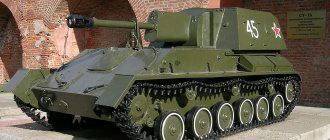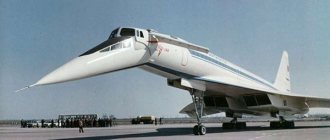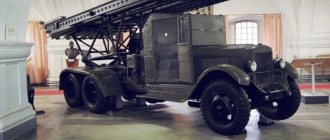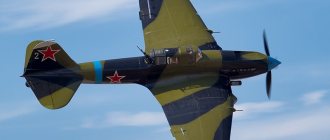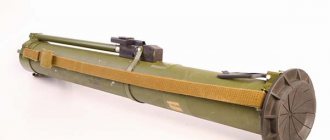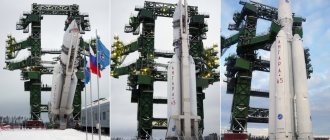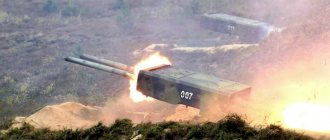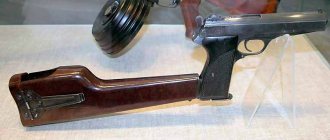Author: Ivan Rzhanov
18 December 2022 21:43
Tags: war choice weapons partisans
5791
8
1
During the Great Patriotic War, Soviet partisans often used homemade submachine guns, created both on the basis of those adopted in the army and their own, sometimes very original, design.
0
See all photos in the gallery
0
The PPD-40 was perhaps the first domestic submachine gun to appear in partisan detachments. Red Army soldiers and border guards who found themselves in partisan detachments had PPD, and then the production of these weapons was established in partisan workshops. It is noteworthy that if in factory conditions the production of PPSh was simpler, more technologically advanced and cheaper, then for the partisans the PPD turned out to be more optimal, the main components of which were made from pipes of various diameters. The barrel of the submachine gun was made from the barrels of a Degtyarev machine gun (DP-27) or rifles; a long rifle barrel was sawn into several parts and could be used to produce two or three submachine guns.
0
PPSh-41 is the most popular submachine gun not only of the Red Army, but of the entire Second World War. But in partisan detachments, the production of this model in comparison with other submachine guns was very difficult. It required the presence of powerful pressing equipment, which partisan detachments naturally could not have, so in production stamping was often replaced by forging. The second problem was the production of disk magazines, which required the release of a feeder spring, which is very problematic to create outside the factory. Therefore, even homemade PPSh released by partisan detachments most often had factory-made magazines. But the production of sector magazines with 35 rounds of ammunition for PPSh was, on the contrary, easily mastered in partisan workshops. The photo shows a homemade horn.
0
The Sudaev system submachine gun appeared in the middle of the war and initially the main production fell on the enterprises of besieged Leningrad. Subsequently, weapons gradually spread among the troops and partisan detachments. A simple and technologically advanced submachine gun was made from sheet steel, which was available to the partisans. However, since the PPS became widespread during the period when the Red Army was already conducting mainly offensive operations, gradually transferring hostilities to the territory of other countries, the PPS did not have time to become widespread among partisan detachments. In museum collections there are a number of teaching aids that belonged to partisans, as well as those produced handicraft in partisan workshops.
Concealed carry submachine gun designed by Sergeev
0
The submachine gun created by Sergeev differed favorably from other models in its compactness and the ability to be carried secretly under clothing. The peculiarity of the weapon was that the weapon was cocked using a front sight that moved in the barrel casing. When moving backwards, the rods rest against the front of the bolt and pull it back. The receiver was made of sheet steel by forging; The shutter is similar to that used on the PPSh-41. The presence of two triggers ensured single and continuous fire in the absence of a fire translator. The disadvantage of the weapon was the lack of fixation of the front sight and the possibility of involuntary cocking. The absence of a shoulder rest also has a negative effect on aimed fire, and effective shooting is possible only at an extremely short distance.
Ammunition
The ZM-50 incendiary mine is designed to ignite various objects: wooden buildings, ammunition and equipment warehouses, vehicles, wooden shelters and other combustible objects. ZM-50 consists of a body (made of Electron alloy) with a stabilizer, a head with a pin, a thermite and a delayed-action igniter located in the tail section. The device is similar to the VEZG-40 incendiary grenade designed by KB-30. In contrast, the mine has a point on the head sleeve to penetrate the thickness of the obstacle and hold it firmly there.
Incendiary mine ZM-50
© letopis.
belta. by The FM-50 high-explosive mine is designed to destroy firing points, infantry groups, vehicles, light buildings and shelters. FM-50 consists of a metal body with a stabilizer, a bursting charge, a head bushing for a fuse and an M-50 type instantaneous fuse with a plastic body. It was forbidden to screw in the standard M-50 fuse. A fuse firing pin extended by 3 mm and a red ring stripe appearing on it indicate a cocked state - in this case, the weapon is unacceptable for handling and use.
The BM-50 armor-piercing mine is designed to destroy armored vehicles, tanks, locomotives, firing points, light pillboxes and other armored objects with armor no more than 30 mm thick. The BM-50 consists of a metal body with a stabilizer, a bursting charge, a head sleeve, an insert detonator and an instantaneous fuse with a mechanism from the standard M-50 fuse.
Submachine gun designed by V. N. Dolganov
0
The submachine gun created by Dolganov is designed for automatic fire only. The weapon has a sector sight at 500 meters; The front sight is protected by a namushnik. Food is supplied from a sector magazine developed by Dolganov or a disk magazine from PPSh. The stock is retractable, but due to its weak fastening it is unreliable when shooting. The advantage of the weapon was its relatively small dimensions and original bolt design.
Gun-mortars of other systems
For the sake of objectivity, it is worth saying that during the Great Patriotic War, many similar rifle mortars were developed - mainly for throwing standard 50-mm mines. Standing apart among them is the R-50 rocket-propelled gun-mortar, developed by NII-1 for the BShPD and tested in April 1943. The R-50 did not withstand the tests and showed unsatisfactory results in terms of accuracy of fire.
In addition, for the BSHPD, plant No. 711 produced 5 gun-mortars designed by Bondarev. You can also recall S. M. Gonorovsky’s gun-mortar; a rifle mortar designed by Fisenko was tested. All rifle systems for firing a standard 50-mm mine had an unacceptable level of recoil and thus practically excluded direct fire. Shooting with the butt resting on the ground was possible, but it led to damage to various elements and components of the rifle.
Guerrilla rifle mortar of unknown design Skorinko G. V., Loparev S. A. Guerrilla weapons, 2014
Later, at STB NII-6, under the leadership of Naiman, the idea of a 50-mm hand mortar was improved, making it more versatile and capable of firing not only mines, but also hand grenades. This is how the PG-6 anti-tank grenade launcher appeared, intended not only for standard 50-mm mines, but also for RPG-6 hand-held anti-tank grenades and even RGD-33 fragmentation grenades.
* - for reliable arming of a mine fuse, an additional charge weighing 1.5 g is required
Submachine gun designed by Temyakov-Menkin
0
This partisan submachine gun, created by Ya. I. Temyakov and Ya. I. Menkin, was produced in 1944. The weapon was created based on the partisans' familiarity with captured German Volmer submachine guns and domestic PPSh. The submachine gun allows only automatic fire. Food is provided from the sector store. The elongated receiver is also a casing. While the partisan submachine gun is very similar in appearance to Volmer's design, the bolt and safety are similar to those used on the PPSh.
Weapons of guerrilla warfare
With the beginning of the Great Patriotic War, the Soviet Union began active training of partisans to conduct sabotage and reconnaissance operations behind enemy lines. The training of future partisan saboteurs left much to be desired, and at first the effectiveness of their actions was low.
Starinov Ilya Grigorievich (1900-2000) - Soviet military leader, colonel, partisan saboteur, “grandfather of Russian special forces”
Active training of partisan personnel along the “D” line (sabotage) in the Soviet Union was carried out from the mid-20s to the early 30s, after which, due to changes in the war doctrine of the Soviet Union (war with small forces and on foreign territory), it was curtailed. In 1937-38 Personnel trained under the “D” line were subjected to repression, and with the outbreak of the Great Patriotic War, their training had to begin practically from scratch. This was reflected in a similar way on special mine-blasting equipment for partisan saboteurs.
On the railways, partisans caused train crashes (sometimes with the subsequent destruction of rolling stock), undermining rails and crosspieces, exploding bridges, attacking railway stations, destroying communications and signaling equipment, damaging and destroying rolling stock.
The successful actions of the partisans along enemy communications and along railway lines in particular ensured: the destruction of enemy personnel, vehicles and cargo, and diverted enemy forces and resources to protect communications. With all this, the partisans provided significant assistance to the troops at the front.
The effectiveness of the partisans' sabotage work was directly dependent on the availability of explosives, various mine-blasting equipment, the tactics of their use, the level of preparedness of the personnel of groups and detachments, as well as the degree of enemy protection of railway communications and other rear facilities.
The most technically equipped partisan detachments with special mine-explosive equipment are considered to be the partisans subordinate to the Ukrainian Headquarters of the Partisan Movement (USHPD). During the war, the USHPD used 17 different types of mine-explosive devices. A significant role in the development of special equipment for partisans was played by Ilya Grigorievich Starinov, who was the deputy head of the USHPD for sabotage work.
Wheel contactor KZ A - laying the contactor on the rail; B - electrical diagram; B - wheel contactor (general view): 1 - contactor, 2 - battery, 3 - electric detonator, 4 - explosive charge
On average, each crash, in addition to human losses, disabled one locomotive, 5-7 cars (of which at least 2-3 were irretrievable), destroyed tens of meters of track, and the enemy’s weapons, uniforms, ammunition and food also perished and became unusable.
Belarusian partisans, in the absence of explosives and to save them, if possible, used a homemade “wedge” by Tengiz Shavgulidze.
The “wedge” was a metal device weighing 18-20 kg. It consisted of a wedge and a slope lath, fixed on one base, strictly adjusted to the size of the railway rail. The device was secured with bolts. It took a few minutes to install. When running over the “wedge,” the wheels of the locomotive and carriages rose to the height of the tire crest and were transferred along the slope rail from the inner to the outer side of the rail. The train was going downhill.
In February 1943, the partisans successfully tested a new weapon. “Klin” received recognition, and partisan forges began to manufacture it. With his help, more than one echelon was derailed in Belarus.
In the first months of the war, the partisans used mainly homemade mines, as well as some army service mines (in particular the TM-35 anti-tank mine and the PMK-40 anti-personnel mine), which were partially converted. But these mines did not satisfy the requirements of the partisans and, for lack of anything better, they showed miracles of ingenuity and created the mine-blasting equipment they needed themselves. As a result, the arsenal of partisan sabotage groups was replenished with necessary, sometimes completely unexpected, types of mines, the secret of which was known only to the inventor and executor of the sabotage action.
During the war, guided mines, instant-action mines, and delayed-action mines were used to influence enemy railway communications.
It did not take much time for the partisans to lay mines. Thus, it took about one minute to install a high-speed special mine, and 8-10 minutes to install a delayed-action mine to a depth of 20-30 cm using two miners.
Wheel short circuit contactor
Statistics on train derailments caused by mine explosions show that 42% of the derailments involved instantaneous mines, 36% involved delayed mines, and the rest were controlled mines.
The explosion of a controlled mine was carried out using an MUV or VPF fuse installed in a charge (a mechanical “fishing rod”). A string was tied to the fuse pin, which stretched 50-120 meters away from the path, from where the charge installation site was clearly visible. When the train was 5-10 meters from the set charge, the partisans in the shelter pulled out the pin with a jerk of string, and an explosion occurred.
Some partisans used an electric “fishing rod”, where the fuse was replaced by an electric detonator (or an electric igniter with a detonator cap), a pocket battery and a contactor. A “fishing rod” was also used with a blasting machine (at that time there was no contactor), however, due to the heaviness of the machine, this type of “fishing rod” was not widely used.
An example of the successful use of a guided mine is the detonation of a train with long platforms on which there were long-range guns for shelling Leningrad by a small partisan detachment under the command of engineering officer F. Gullon, operating in the area of Luga, Leningrad Region. The partisans planted a charge 5 meters from the unguarded bridge. When the charge was detonated, the lead locomotive drove into a funnel and fell down a slope; The second locomotive fell after it, dragging the platforms with the guns along with it. The partisans rushed to the train, destroyed its guards, after which, taking the trophies, they set the train on fire and disappeared.
Another successful example is the actions of the sabotage group under the command of Simonenko of the “For the Motherland” partisan unit. On April 8, 1943, the partisans mined a ten-meter bridge with 50-kilogram aerial bombs, into which they inserted TNT drilling blocks with fuses from F-1 grenades. The cords from the rings with fuses were stretched 100-120 m into the shelter. As the train approached the bridge, the partisan pulled the cord and blew up the bridge in front of the locomotive. The wreckage of the bridge, along with the locomotive, fell into the river, and four carriages fell down a slope.
Delayed action mine MZD-5 A - general view; B - mine with an open lid; B - plan and electrical wiring diagram of the mine: 1 - electrochemical fuse EHV, 2 - SBO battery, 3 - VZ-1 contactor, 4 - 400-g checker, 5 - wires for connecting an electric detonator, 6 - electric detonator, 7 - housing, 8 - cover, 9 - bracket, 10 - block
The partisans who used guided mines had to have great skill and composure to detonate the mine in front of the locomotive. In addition, it took a lot of courage to stand guard in close proximity to a mine, running the constant risk of being discovered by an enemy patrol.
The advantage of these mines was the ability to undermine precisely that echelon that was of greatest interest to the partisans. In addition, if a controlled mine was detected by the enemy, it could be detonated and thereby still cause damage to the enemy. This is what a group of miners under the command of Breslav from Yaremchuk’s partisan detachment did in June 1943. A soldier on patrol accidentally discovered a mine under a rail. All the other members of the patrol came up to his call, and, seeing that the mine had been discovered and could be neutralized, the group commander detonated the mine. All ten soldiers on the patrol were killed.
In connection with the increasing frequency of sabotage by partisans on the enemy’s railway communications, the occupiers began to take measures to protect the railways. They began to cut down the forest 100-200 m on both sides of the road, create rubble, mine the approaches, carry out warning shelling of the forest along the roads, and set up patrols. The railway track itself was also specially treated: the ballast between the sleepers was poured with lime, chalk and other dyes; they began to remove ballast from under the rails by 5-15 cm, etc. But the partisans very successfully overcame these tricks.
During all the war winters, due to the difficulty of masking the traces of mine-laying work, the partisans began to use high-speed mines, or, as they were also called, “impudent” mines. With this method of mining, the demolition worker ran onto the track directly in front of a passing train. This method of mining was also used on sections of railways where it was not possible to wreck enemy trains by other means, and required great courage and ability from demolition men to quickly lay mines.
Table 1.
In addition to “impudent” mines, the partisans also used instant mines, both industrially produced and homemade. Homemade mines include the “VPF on a stick” (aka “guitar” or “balalaika”), “wheel locker” and “capsule with DS” (the last two mines are designs by I.G. Starinov). The first two devices accounted for 9.5% of the total number of mines installed. “Wheel locker” and “primer with long shot” were used when using “cheeky” mines. The partisans also used mines with MV-5 pressure fuses (UP-MV mine), and replaced the pin on the MUV fuse with a stylus (“MUV with graphite”) or a match.
A successful example of the use of an instant mine “VPF on a stick” is the sabotage of V.I.’s group. Klokov, conducted in February 1943. Klokov’s group managed to get to about 20 m from the railway and disguise themselves. When the train was no more than 1 km from the group’s location, Klokov and one miner jumped onto the track, quickly laid a mine and moved away from the track. As a result of the crash, 4 carriages were broken and the locomotive was damaged.
One more example. In March 1943, two steam locomotives traveling in reserve were blown up by a mine with a “wheel lock” installed by the commander of the sabotage group Kvitinsky from Grabchak’s formation. When a mine exploded, both locomotives derailed, and traffic on the stretch stopped for 13 hours.
At the end of the first period of the war, Soviet industry mastered the production of special mine-blasting equipment for partisans, which made it possible to use it en masse. The partisans were armed with delayed-action mines with electric time and chemical fuses, magnetic and other special mines. A significant role in the development of technical requirements and some samples of this equipment belongs to I.G. Starinov. On his instructions, GSKB-47 developed a number of special mines for partisans, in particular: a block for blowing up a second train (Blok-47), a terrorist non-retrievable mine TMN-47 (two options), a river mine RM-47, a hook-on pavement or tunnel railway mine mine (PMZhD) and a number of other types of special equipment.
MZD-5
The table from the application dated September 30, 1943 from the Chief of the Central Headquarters (TsShPD) of the partisan movement to the Chief of the Red Army Engineering Troops (KA) for the production of mines for the partisans that are not in service with the KA (see Table 1) gives some idea of the scope of the sabotage activities of the partisans behind enemy lines. ).
Delayed action mines (DAM) made it possible to install several mines during one sabotage group’s exit onto the railway track, which could disrupt train traffic on a given section of the road for a long period of time.
A fairly successful example of the use of MSD is the installation on March 28, 1943 by the Malysh sabotage group of 5 minutes with a delay of 24 hours. On March 20, a train with coal was blown up, as a result of which 13 cars were broken, about 100 m of track were destroyed and 10 Germans were killed. Two days later, another train was blown up by a second mine. The enemy discovered the remaining three mines and detonated them on the spot, severely damaging the path.
To enhance the effect of the train's collapse, the partisans fired at it, thereby causing even more damage.
Steam locomotives were also fired at from anti-tank rifles (ATR). Shooting from the PTR was carried out by excellent shooters, because Only if it hit the middle third of the diameter of the cylindrical part of the locomotive was it disabled.
In August 1943, on the Drovyanoy Post - Poyaski stretch, the locomotive was fired upon from an anti-tank rifle. The boiler and 4 pipes inside were broken. The train stood on the line for 4 hours until an auxiliary locomotive came to pick it up.
Guerrilla road mine PDM-1 A - general view; B - section; B - lead moderator; 1 - body, 2 - detachable wall, 3 - hinged lock, 4 - partition, 5 - rubber ring, 6 - metal washer, 7 - panel, 8 - pressure rod, 9 - cap (head), 10 - bracket, 11 - spring, 12 - safety pin, 13 - ring, 14 - frame, 15 - frame axis, 16 - tip, 17 - cutting wire, 18 - frame spring, 19 - lead plate, 20 - bracket, 21 - tube, 22 - checker BB, 23 - rubber gasket
More significant damage to the enemy was caused by blowing up bridges, because their restoration required more time, but the enemy carefully guarded the bridges. Therefore, this type of sabotage was usually associated with a battle to capture the bridge and required significant forces. For this reason, bridge explosions were not as common as compared to the derailment of enemy trains.
The destruction of large and medium-sized bridges led to quite long interruptions in the movement of trains. In most cases, blowing up small bridges did not give the desired effect. The effect of exploding small railway bridges increased significantly if, simultaneously with the explosion of the bridge, the enemy suffered significant damage and the interruption in traffic reached three or more days.
Only large detachments and formations of partisans could attack medium and large railway bridges.
The delay in traffic when medium and large bridges were blown up ranged from 5 to 30 days, when small bridges were blown up - 28 hours without a train crash and 60 hours with a simultaneous train crash.
An example of such an operation is the explosion of a bridge across the river. Uza on the Pskov-Porkhov railway, carried out on February 8, 1943 by a partisan detachment under the command of I.A. Bykova. The bridge was guarded by a reinforced garrison; bunkers and trenches were prepared for its defense, and the approaches were covered with barriers.
Lever mine
The partisans resorted to cunning. 4 partisans, fluent in German, talking animatedly, moved along the railway track towards the guard. The guards mistook them for their own, and the partisans silently destroyed them. Then they approached the sentries on the opposite side and opened fire on them, which served as a signal for the detachment’s strike group to rush to the enemy barracks. The enemy garrison was destroyed. After the bridge explosion, the partisans retreated in an organized manner to the gathering area.
When heavily guarded bridges were undermined or there were not enough people, the partisans showed considerable ingenuity.
Thus, demolition instructor Ushakov blew up a bridge across the river in September 1943. Ingul near the city of Kirovograd, delivering explosives to the bridge through the water on a car tube. He delivered the explosives for 18 nights in a row and placed them in special mine niches in the coastal abutment of the bridge and in one bull. The explosion caused a farm to collapse.
An unusual act of sabotage involving the explosion of a railway bridge across the river. The cleaning near the Olevsk station was carried out in October 1943 by A.M. Grabchak’s detachment. To destroy a heavily guarded facility, the partisans mounted a homemade torpedo on a trolley in the forest, far from the bridge. A motor vehicle engine was used as an engine, and a 100-kg aerial bomb (FAB-100) was used as a charge. At 4 o'clock on October 31, the torpedo was brought to the railway and placed on the track 900 m from the bridge. Having installed a scarecrow with a lantern on it, the partisans started the engine and aimed the torpedo towards the bridge. At the entrance to the bridge the fuse went off. As a result of the explosion, the bridge was severely damaged and traffic stopped for three days, while repairs to the bridge continued for another two weeks.
Partisans of the “People's Avenger” detachment of the Temkinsky district are mining the railway track. Photo: www.victory.rusarchives.ru
There were also factory developments of railway torpedoes for partisans. So, there was a special cart for Captain Tikhomirov, with batteries and an electric motor. There were difficulties with calculating the explosive charge to destroy the bridge using this trolley. The cart was planned to be used with an explosive charge of 400 kg (the mass of the cart itself is about 100 kg). At the end of 1943, several groups with 10 carts were deployed, but they could not be used due to a lack of fuel in the partisan formations.
Also for Tikhomirov’s carts, the USHPD Technical Department has developed a directional charge. On August 3, 1943, the charge was tested at the test site. A charge weighing 62 kg at a distance of 2 m broke a metal I-beam 100 mm high. The charges were manufactured by the GSKB-47 plant and received by the USHPD in January 1944. They were transported to the base in Rivne, but they could not immediately transfer them and the carts to the partisans. During an enemy air raid, an aerial bomb hit the USHPD warehouse and the charges were destroyed. After this it was no longer possible to use charges with carts.
Underground partisans at railway stations took a significant part in sabotage on the railways. They mined enemy military trains with magnetic mines, damaged switches and locomotives, poured sand into the axleboxes, etc.
The largest sabotage of the Great Patriotic War (and possibly the Second World War) was carried out by saboteur F.A. Krylovich. Early in the morning of July 30, 1943, he planted two magnetic mines in a train with gasoline that stopped at the Osipovichi junction station (Belarus). At the moment of the explosion, the mined train was next to three other trains loaded with ammunition and military equipment. As a result of sabotage, 5 locomotives, 25 tanks with gasoline, 8 tanks with aviation oil, 65 wagons with ammunition, 12 wagons with food, 8 tanks on platforms (5 of them Tiger type), 7 armored personnel carriers and station buildings were completely burned or exploded. . Traffic in this area was completely interrupted for two days.
A German train destroyed by partisans. 1943
Groups of underground partisans in the depot were also quite active. They sabotaged the repair of rolling stock, damaged the equipment of repair shops, and planted “coal” mines in the coal warehouses of stations and tenders of steam locomotives. The “coal” mine looks like an ordinary piece of coal - and when it got into the firebox, it exploded and disabled the locomotive. Using such mines, a group of partisans under the command of Zaslonov, operating at the Orsha station depot, from October 1941 to January 1942, caused about 100 train crashes, blew up 93 steam locomotives and carried out a number of other acts of sabotage.
The partisans carried out quite a significant number of attacks on small railway stations. After the attack on the station, the Germans fortified all railway stations in the zone of active partisan operations and maintained significant garrisons there. For this reason, attacks on large stations were relatively rare.
One of the successful examples of such operations is the attack of partisans of the Kovpak formation on the Olevsk station in October 1943. Due to artillery shelling of the trains accumulated at the station, a fire broke out, as a result of which all the trains were destroyed. The movement stopped for two days.
A German train destroyed by partisans. 1943
Sabotage took on a special scale with the arrival of MZD-4 and MZD-5 mines, which were Special Security Equipment (TOS), to the partisans. They allowed groups of miners, after installation, to go far from the site of sabotage and remain unharmed. The partisans also successfully used other factory-made anti-vehicle mines: PMS and PDM-1. They had shorter deceleration times than mines of the MZD series. PDM-1 could explode under the second train passing over it.
In the second half of 1944, special portable radio mines entered service with the partisans. Unfortunately, there are no accurate and reliable data on these mines, because this was also TOS and they were used to a limited extent. The composition of the radiomin was as follows: TDF device, KTU FTD, KMV-1, quartz, code blocks. These mines were easily portable receiving and transmitting devices that made it possible to detonate at a distance within line of sight.
Radiomines were used by Soviet partisans in Eastern European countries.
Improving the quality of communications between partisans and the rear, improving the level of training of partisan personnel and the emergence of new models of mine-explosive equipment made it possible to develop and carry out mass sabotage on enemy railway communications at the time of important military operations at the front.
Such operations began to be carried out already in the fall of 1942, in particular, partisan attacks on certain sections of the railways in the Mginsk direction (assistance to the Volkhov and Leningrad fronts) and the Rzhev direction (assistance to the Kalinin and Western fronts). In December 1942, an operation was being developed to disrupt enemy transport on the main railway communications in the western direction. The plan provided for the installation of from 150 to 450 MZD on 1 or 3 sections of the railway Polotsk - Molodchenko (1 section), Orsha - Minsk - Baranovichi (3 sections), Mogilev - Gomel (1 section), Minsk - Osipovichi - Bobruisk (1 section) , Gomel - Pinsk - Brest (3 sections). This operation was not performed.
Examples of large-scale sabotage are the massive rail explosion operations "Rail War" (August - September 1943), "Concert" (September - October 1943) and "Winter Concert" (winter 1943/44). The partisans undermined the rails with special sabers weighing 60 g of the PSh-2 brand (partisan saber of the 2nd model). In testing conditions, these checkers knocked out a piece of rail 60-80 cm long, but in battle these checkers performed poorly (since their fast and high-quality driving was not ensured), and the partisans began to undermine the rails with checkers weighing 200 g or 200 g checkers with one rounded edge (for ease of fastening to the rail).
A German train destroyed by partisans. 1943
As a result of a one-time massive attack by partisans, the railway capacity was reduced by 30-40%. However, the Germans had an excess of rails, and they could replace them quite quickly, and subsequently, in order to avoid delays in movement, the enemy began to use overhead bridges 80 cm long and weighing about 20 kg, laid on a knocked out piece of rail (with the approach of the repair train, replacement was carried out rail).
In parallel with Operation Rail War, Operation Desert was carried out, the purpose of which was to disable the main and auxiliary water supply routes of railway stations and junctions of seven railways. Due to the coincidence in timing with the “Rail War,” Operation Desert (from August to December 15, 1943) was generally 18.5% completed—43 water pumping stations out of 232 planned were destroyed. In addition, the partisans destroyed: 6 pressure water pipelines, one dam, 6 water towers and 4 hydraulic columns. Operation Desert itself was not particularly successful, but it was a good addition to the Rail War.
The partisans also carried out special operations to block traffic through railway junctions. An excellent example of such an operation is the attack on the Kovel railway junction carried out by A. Fedorov’s formation.
In this operation, the railway sections at the Brest and Kovel junction were distributed between the detachments. Each detachment installed 20-30 MZD on its section of the road. After installing the MZD, the partisans began using instant mines to undermine enemy echelons. As a result of this operation, the capacity of the Kovel - Sarny - Kyiv section fell by 6 times, Kovel - Rivne by 2.5 times.
The partisans' accumulation of experience in sabotage on the enemy's railway communications allowed them to increase their strike efforts, as evidenced by the following figures: Leningrad partisans caused 297 train wrecks in 1942; in 1943 - 466; Ukrainian partisans derailed 233 enemy echelons in 1942, and 3666 in 1943; Belarusian partisans in the first half of 1942 carried out an average of 20 crashes of enemy trains per month, in the second half of the year - 150, in the first half of 1943 - 294, in the second half of the year - 744.
When mining railways and destroying trains that crashed, the partisans suffered minor losses, not exceeding an average of 1-2 people per 10 trains.
The collapse of a German military train, organized by one of the partisan detachments. Photo: www.victory.rusarchives.ru
According to rough estimates, during the war years, Soviet partisans derailed about 20 thousand enemy trains and 58 armored trains on railway communications. 10 thousand steam locomotives, 110 thousand cars, platforms and tanks, 12 thousand bridges on railways, highways and dirt roads were blown up and disabled. As a result of operations “Rail War” and “Concert”, 363 thousand rails were destroyed, which amounts to 2270 km of single-track railway track.
In percentage terms, the use of mine-explosive weapons by Ukrainian partisans looks something like this: 1) MZD-5 mine (“queen” of partisan mines) - 35%; 2) guided mines (on a “fishing rod”) - 20-25%; 3) partisan anti-clearance mines - 9.5%; 4) PMS mine - 6%; 5) “Wheel lock” - 5.3%, “Capsule with LSh” - 5.5%; 6) “MUV for graphite” - 4.25%; 7) mechanical destruction of the track - 2.5%. Total 89%, the remaining 11% in the design: 1) MV-5, PMK-40 - 2% each; 2) PV-42 and NM - 1% each; 3) push - 4.5%; 4) push under the rail.
Unfortunately, the data regarding the damage inflicted by the partisans on the enemy is inaccurate. There are significant discrepancies in numbers between Soviet and German archival data. Checking them is a very painstaking task, but from the data provided it is clear that the partisans inflicted serious damage on the enemy, thereby also bringing Victory Day closer!
The article was published in the May 2011 issue of the journal Science and Technology.
Found a typo? Select a fragment and press Ctrl+Enter.
Tags: Materials and technologies Great Patriotic War minecraft Ilya Grigorievich Starinov swarm tactics
Previous article Here it is - Europe. Pe-2 in offensive operations at the end of the war
Next article The last assault. Pe-2 in the Battle of Berlin
Provided by SendPulse
Likes 0
Soviet partisans in popular culture
As war heroes, partisans appeared in many Soviet films devoted to military themes. Among the key films are the following:
"Rising" (1976). "Konstantin Zaslonov" (1949). The trilogy “The Thought of Kovpak”, published from 1973 to 1976. “Partisans in the steppes of Ukraine” (1943). “In the woods near Kovel” (1984) and many others. The above-mentioned sources say that films about partisans began to be made during military operations - this was necessary so that people would support this movement and join the ranks of the Resistance fighters.
In addition to films, the partisans became heroes of many songs and ballads that highlighted their exploits and carried the news about them among the people.
Now streets and parks are named after famous partisans, thousands of monuments have been erected throughout the CIS countries and beyond. A striking example is Burma, where the feat of Zoya Kosmodemyanskaya is honored.
Children-partisans
The phenomenon of child partisans deserves special attention. School-age boys wanted to fight the invader. Among these heroes it is worth highlighting:
- Valentin Kotik;
- Marat Kazei;
- Vanya Kazachenko;
- Vitya Sitnitsa;
- Olya Demesh;
- Alyosha Vyalov;
- Zina Portnova;
- Pavlik Titov and others.
Boys and girls were engaged in reconnaissance, supplied brigades with supplies and water, fought in battle against the enemy, blew up tanks - did everything to drive away the Nazis. Children partisans of the Great Patriotic War did no less than adults. Many of them died and received the title of “Hero of the Soviet Union.”


